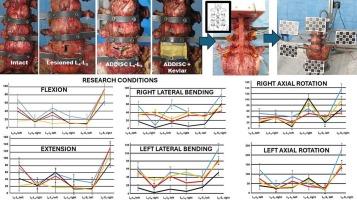Reducing facet joint overload with a Kevlar-augmented lumbar disc replacement: An ex vivo investigation
IF 1.4
3区 医学
Q4 ENGINEERING, BIOMEDICAL
引用次数: 0
Abstract
Background
Facet joint overload often causes persistent low back pain after lumbar total disc replacement (TDR). This study is the first to test whether adding an anterior Kevlar band (K) can restore normal facet joint loading after lumbar TDR.
Methods
We tested six human lumbosacral spines under four conditions: intact, after discectomy, with the ADDISC prosthesis, and with ADDISC plus Kevlar reinforcement. Facet joint pressures were measured at L3–L4, L4–L5, and L5–S1 during flexion, extension, lateral bending, and axial rotation.
Findings
Discectomy caused a significant rise in facet pressures, especially during extension and axial rotation (p < 0.01). The ADDISC prosthesis lowered facet pressures but did not fully return them to baseline. Kevlar reinforcement lowered pressures by up to 35 % compared to the prosthesis alone, nearing intact spine levels, especially in flexion and extension.
Interpretation
Kevlar reinforcement improves load distribution more than the prosthesis alone. It may help prevent facet degeneration and adjacent segment disease, offering a better biomechanical option for motion-preserving spine surgery.
Clinical relevance
The combination of the ADDISC prosthesis and Kevlar reinforcement may help prevent facet joint degeneration and adjacent segment disease, potentially enhancing long-term outcomes in lumbar disc arthroplasty.

用凯夫拉增强腰椎间盘置换术减少小关节负荷:一项离体研究。
背景:腰椎全椎间盘置换术(TDR)后,关节突关节负荷过重常引起持续性腰痛。本研究首次测试了在腰椎TDR后添加前路Kevlar带(K)是否可以恢复正常的小关节负荷。方法:我们在四种情况下测试了6根人腰骶棘:完整、椎间盘切除术后、ADDISC假体和ADDISC加Kevlar加固。在屈曲、伸展、侧向弯曲和轴向旋转时测量L3-L4、L4-L5和L5-S1关节突关节压力。研究结果:椎间盘切除术导致关节突压力显著增加,尤其是在伸展和轴向旋转时(p)。解释:凯夫拉纤维加固比单独使用假体更能改善负荷分布。它可能有助于预防关节突退变和邻近节段疾病,为保持运动的脊柱手术提供更好的生物力学选择。临床意义:ADDISC假体和凯夫拉纤维加固的结合可能有助于预防小关节退变和邻近节段疾病,潜在地提高腰椎间盘置换术的长期疗效。
本文章由计算机程序翻译,如有差异,请以英文原文为准。
求助全文
约1分钟内获得全文
求助全文
来源期刊

Clinical Biomechanics
医学-工程:生物医学
CiteScore
3.30
自引率
5.60%
发文量
189
审稿时长
12.3 weeks
期刊介绍:
Clinical Biomechanics is an international multidisciplinary journal of biomechanics with a focus on medical and clinical applications of new knowledge in the field.
The science of biomechanics helps explain the causes of cell, tissue, organ and body system disorders, and supports clinicians in the diagnosis, prognosis and evaluation of treatment methods and technologies. Clinical Biomechanics aims to strengthen the links between laboratory and clinic by publishing cutting-edge biomechanics research which helps to explain the causes of injury and disease, and which provides evidence contributing to improved clinical management.
A rigorous peer review system is employed and every attempt is made to process and publish top-quality papers promptly.
Clinical Biomechanics explores all facets of body system, organ, tissue and cell biomechanics, with an emphasis on medical and clinical applications of the basic science aspects. The role of basic science is therefore recognized in a medical or clinical context. The readership of the journal closely reflects its multi-disciplinary contents, being a balance of scientists, engineers and clinicians.
The contents are in the form of research papers, brief reports, review papers and correspondence, whilst special interest issues and supplements are published from time to time.
Disciplines covered include biomechanics and mechanobiology at all scales, bioengineering and use of tissue engineering and biomaterials for clinical applications, biophysics, as well as biomechanical aspects of medical robotics, ergonomics, physical and occupational therapeutics and rehabilitation.
 求助内容:
求助内容: 应助结果提醒方式:
应助结果提醒方式:


